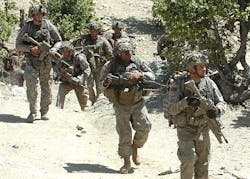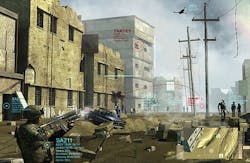Lockheed Martin eyes prototypes for infantry squad situational awareness and communications
Officials of the U.S. Army Contracting Command at Aberdeen Proving Ground, Md., announced a $12.9 million contract Thursday to the Lockheed Martin Missiles and Fire Control segment in Grand Prairie, Texas, for the Squad X Core Technologies (SXCT) program.
The Army Contracting is making the award on behalf of the U.S. Defense Advanced Research Projects Agency (DARPA) in Arlington, Va. The SXCT program seeks to make small units of Army and U.S. Marine Corps infantry warfighters more effective and deadly using existing weapons and unmanned systems.
This award moves the SXCT program to the prototyping phase. Lockheed Martin has been working on the program since fall 2015, and was involved in the first and second phases of the project.
Also working on the SXCT program's first phase were Helios Remote Sensing Systems in Utica, N.Y.; Kitware Inc. in Clifton Park, N.Y.; Leidos in Reston, Va.; the Lockheed Martin Advanced Technology Laboratories in Cherry Hill, N.J.; the Raytheon Co. Missile Systems segment in Tucson, Ariz.; Scientific Systems Co. Inc. in Woburn, Mass.; Six3 systems Inc. in McLean, Va.; SoarTech in Orlando, Fla.; and SRI International in Menlo Park, Calif.
Related: Army eyes hand-launched squad drone the weight of a baseball for battlefield surveillance
U.S. infantry rifle squads today lack 21st century combat power, DARPA official explain. They do not have the ability to switch from offensive and defensive operations to stability operations and back again, which can produce a high number of casualties.
With these disadvantages, today's infantry warfighter faces an adversary that on its own terrain has ubiquitous communications, hides in the terrain or culture, and follows different rules of engagement. The result is that U.S. military squads have less situational awareness than their adversaries, with sensing limited by line of sight and narrow fields of view.
To rectify these problems, the DARPA SXCT program seeks to develop capabilities that enhance the dismounted rifle squad’s situational awareness, as well as to build the rifle squad's combat power to adapt to a broad range of military operations.
The SXCT program has four technology thrusts: precision engagement, non-kinetic engagement, squad sensing, and squad autonomy. Precision engagement seeks to enable the rifle squad to engage threats precisely out to 1,000 meters while maintaining compatibility with infantry weapon systems and human factors limitations.
DARPA wants to develop technologies that help enable the rifle squad to engage known-but-unseen threats with new kinds of guided weapons that are compatible with current squad equipment like the M203/M320 grenade launchers or the Picatinny Rail system.
Related: As the infantry adapts to commercial technology, questions remain on how best to use it
Researchers particularly are interested in a micro-missile or advanced 40-millimeter grenade that can engage unseen targets with precision using the networked squad, small unmanned vehicles, data-fusion-enabled shared situational awareness.
Squad sensing seeks to enable the rifle squad to detect and pinpoint hidden human threats out to 1,000 meters while maneuvering at a squad pace. DARPA particularly is interested in approaches that might involve acoustic sensor arrays, handheld radar, human heartbeat monitors, and infrared sensors.
Squad autonomy, finally, seeks to enable rifle squad members to keep track of each other and their unit's location to less than six meters in GPS-denied environments by collaborating with unmanned systems maneuvering in squad formations.
This could involve the collaboration of squad members and unmanned systems, and to enable robots operating with the squad to maneuver as members of the squad formation.
Related: Infantry soldiers to become walking weapon systems
A small unmanned aerial vehicle (UAV), for example, could operate 100 to 200 feet above and in front of the squad to track squad members and take cues from squad maneuvers. An unmanned ground vehicle (UGVs) might operate in front of the squad as an advance scout. Other UGVs could operate with the squad to carry supplies and communications gear.
DARPA particularly is interested in non-active sensors, or those with minimal signatures like spread-spectrum light detection and ranging (LIDAR). Sensors need to be small, lightweight, and power efficient.
In the first phase of the SXCT program Lockheed Martin and SRI International developed concepts in each of the four technological areas. In the second phase Lockheed Martin enhanced promising technologies from the first phase. Now Lockheed Martin will develop prototypes for field testing.
On this contract Lockheed Martin will do the work in Grand Prairie, Texas; Rome, N.Y.; Menlo Park, Calif.; Woburn, Mass.; Ann Arbor, Mich.; and Cherry Hill, N.J., and should be finished by August 2019.
For more information contact Lockheed Martin Missiles and Fire Control online at www.lockheedmartin.com/us/mfc.html, the Army Contracting Command-Aberdeen at http://acc.army.mil/contractingcenters/acc-apg, or DARPA at www.darpa.mil.
Learn more: search the Aerospace & Defense Buyer's Guide for companies, new products, press releases, and videos

